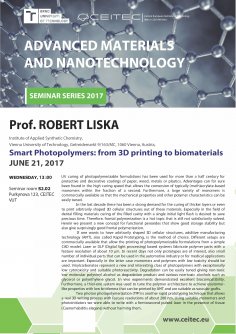SPEAKER´S CV
Robert Liska was born in 1969 in Vienna, Austria. He received his M.Sc. degree in 1995 and Ph.D. degree in 1998 from the Vienna University of Technology where he continued his academic career afterwards. In 2006, he got his habilitation in the field of macromolecular chemistry at the Institute of Applied Synthetic Chemistry. He is the leader of the research group ''Photopolymerization'' and his current research interests are in the field of photoinitiation, photopolymerization, 3D-printing, and biomedical polymers. He has co-authored 8 book chapters and published more than 120 papers in peer reviewed journals. Up to now more than 30 patent families have been filed. Since 2012 he is also the head of the Christian Doppler laboratory for digital and restorative dentistry and member of the Austrian Cluster for Tissue Regeneration. Since 2016 he is full professor for “Organic Technology” at the Institute of Applied Synthetic Chemistry of the TU Wien. Currently, the group consists of 4 post-docs, 11 PhD students and 7 master students
ABSTRACT
UV curing of photopolymerizable formulations has been used for more than a half century for protective and decorative coatings of paper, wood, metals or plastics. Advantages can for sure been found in the high curing speed that allows the conversion of typically (meth)acrylate-based monomers within the fraction of a second. Furthermore, a large variety of monomers is commercially available so that the mechanical properties and other polymer characteristics can be easily tuned.
In the last decade there has been a strong demand for the curing of thicker layers or even to print arbitrarily shaped 3D cellular structures out of these materials. Especially in the field of dental filling materials curing of the filled cavity with a single initial light flash is desired to save precious time. Therefore, frontal polymerization is a hot topic that is still not satisfactorily solved. Herein we present a new concept for functional peroxides that show good storage stability but also give surprisingly good frontal polymerization.
If one wants to have arbitrarily shaped 3D cellular structures, additive manufacturing technology (AMT), also called Rapid Prototyping, is the method of choice. Different setups are commercially available that allow the printing of photopolymerizable formulations from a simple CAD model. Laser or DLP (Digital light processing) based systems fabricate polymer parts with a feature resolution of about 10 µm. In recent days not only prototypes are of interest, also small number of individual parts that can be used in the automotive industry or for medical applications are important. Especially in the latter case monomers and polymers with low toxicity should be used. Vinylcarbonates represent a new and interesting class of photopolymers with exceptionally low cytotoxicity and suitable photoreactivity. Degradation can be easily tuned giving non-toxic low molecular polyvinyl alcohol as degradation product and various non-toxic alcohols such as glycerol or polyethylene glycol. In vivo experiments demonstrated excellent biocompatibility. Furthermore, a thiol-ene system was used to tune the polymer architecture to achieve elastomer-like properties with low brittleness that can be printed by AMT and are suitable as vascular grafts.
Two photon photopolymerization (TPP) is another rapid prototyping technique that allows a real 3D writing process with feature resolutions of about 200 nm. Using suitable monomers and photoinitiators we were able to write with a femtosecond pulsed laser in the presence of tissue
(Caenorhabditis elegans) without harming them.








